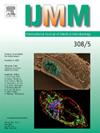用土拨鼠肝炎病毒(WHV)感染模型研究HBV感染对肠道菌群的影响
IF 3.6
3区 医学
Q1 MICROBIOLOGY
引用次数: 0
摘要
乙型肝炎病毒(HBV)感染似乎与肠道微生物群有关。本研究旨在探讨HBV感染对中国土拨鼠肠道菌群的影响及其可能的免疫机制。9只成年土拨鼠随机分为环孢素A (CsA)组和对照组。动物在接种WHV前2周口服CsA和生理盐水,并持续至接种WHV后8周。在给药后2周和停药前检测血CsA浓度。采用定量PCR检测血清WHV DNA。流式细胞术检测T细胞免疫应答。收集粪便进行16S rRNA测序。结果表明,口服CsA可使土拨鼠血药浓度达到有效水平,并能有效延长WHV的复制时间。口服治疗2周后,两组患者肠道菌群差异无统计学意义。在血清WHV清除率时,拟杆菌门普雷沃氏菌和普雷沃氏菌属的相对丰度显著升高,厚壁菌门的相对丰度显著降低。同时,外周血CD4-T细胞的CD107a脱颗粒呈下降趋势,而PD-1+ CD4-T细胞的频率无显著差异。综上所述,口服CsA可显著延长土拨鼠WHV的复制时间。在血清WHV清除过程中,中国土拨鼠的肠道菌群发生了显著变化,这意味着中国土拨鼠模型可以用于研究HBV感染与肠道菌群的相互作用。本文章由计算机程序翻译,如有差异,请以英文原文为准。
The impact of HBV infection on gut microbiota using Chinese woodchuck model with woodchuck hepatitis virus (WHV) infection
Hepatitis B virus (HBV) infection seems to be related to gut microbiota. This study aims to explore the effects of HBV infection on gut microbiota and possible immunological mechanisms using the Chinese woodchuck model. Nine adult woodchucks were randomly divided into Cyclosporine A (CsA) or Control group. Animals were orally treated with CsA and saline for 2 weeks before WHV inoculation, and continued until 8 weeks after that. Blood CsA concentrations were tested at 2 weeks after administration and before discontinuation. Quantitative PCR was used to detect serum WHV DNA. Flow cytometry was used to detect T cell immune response. Feces were collected for 16S rRNA sequencing. The result shows CsA oral administration can reach effective blood drug concentration in woodchucks and successfully prolong WHV replication. After 2 weeks of oral treatment, there was no significant difference in the gut microbiota between the two groups. At the clearance period of serum WHV, the relative abundance of Prevotella and Prevotella genera in the phylum Bacteroidetes significantly increased, while the relative abundance of Firmicutes significantly decreased. Meanwhile, the CD107a degranulation of CD4-T cells in peripheral blood showed a decreasing trend, while there was no significant difference in the frequency of PD-1+ CD4-T cells. In Conclusion, oral administration of CsA can significantly prolong the replication time of WHV in Chinese woodchucks. The gut microbiota of Chinese woodchuck undergoes significant changes during serum WHV clearance, which implies the Chinese woodchuck model can be used to study the interaction between HBV infection and gut microbiota.
求助全文
通过发布文献求助,成功后即可免费获取论文全文。
去求助
来源期刊
CiteScore
9.70
自引率
0.00%
发文量
18
审稿时长
45 days
期刊介绍:
Pathogen genome sequencing projects have provided a wealth of data that need to be set in context to pathogenicity and the outcome of infections. In addition, the interplay between a pathogen and its host cell has become increasingly important to understand and interfere with diseases caused by microbial pathogens. IJMM meets these needs by focussing on genome and proteome analyses, studies dealing with the molecular mechanisms of pathogenicity and the evolution of pathogenic agents, the interactions between pathogens and host cells ("cellular microbiology"), and molecular epidemiology. To help the reader keeping up with the rapidly evolving new findings in the field of medical microbiology, IJMM publishes original articles, case studies and topical, state-of-the-art mini-reviews in a well balanced fashion. All articles are strictly peer-reviewed. Important topics are reinforced by 2 special issues per year dedicated to a particular theme. Finally, at irregular intervals, current opinions on recent or future developments in medical microbiology are presented in an editorial section.

 求助内容:
求助内容: 应助结果提醒方式:
应助结果提醒方式:


